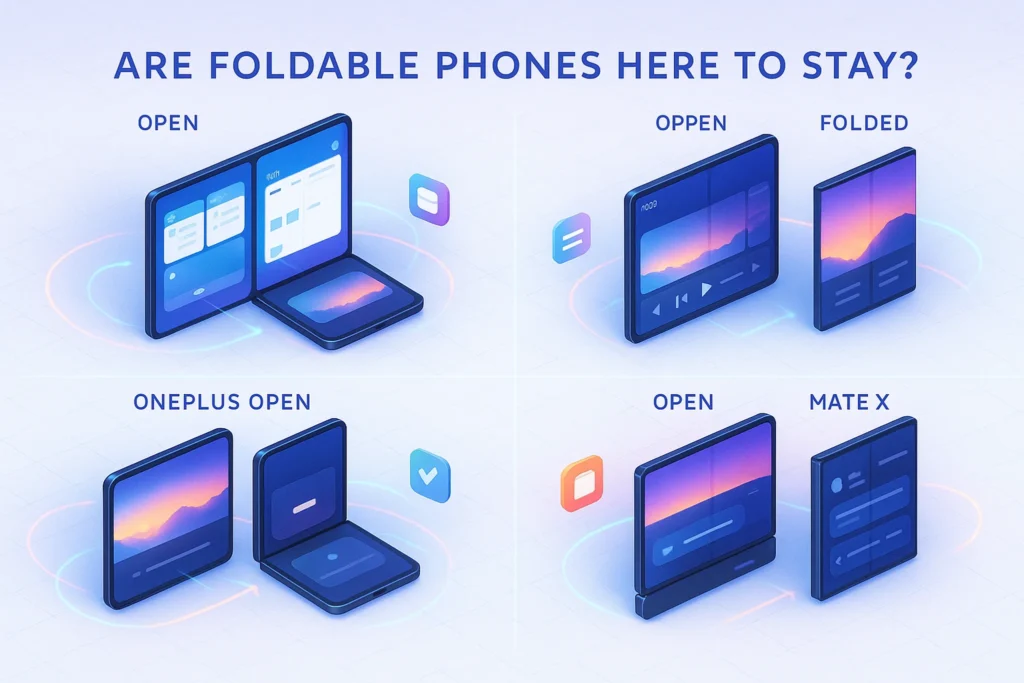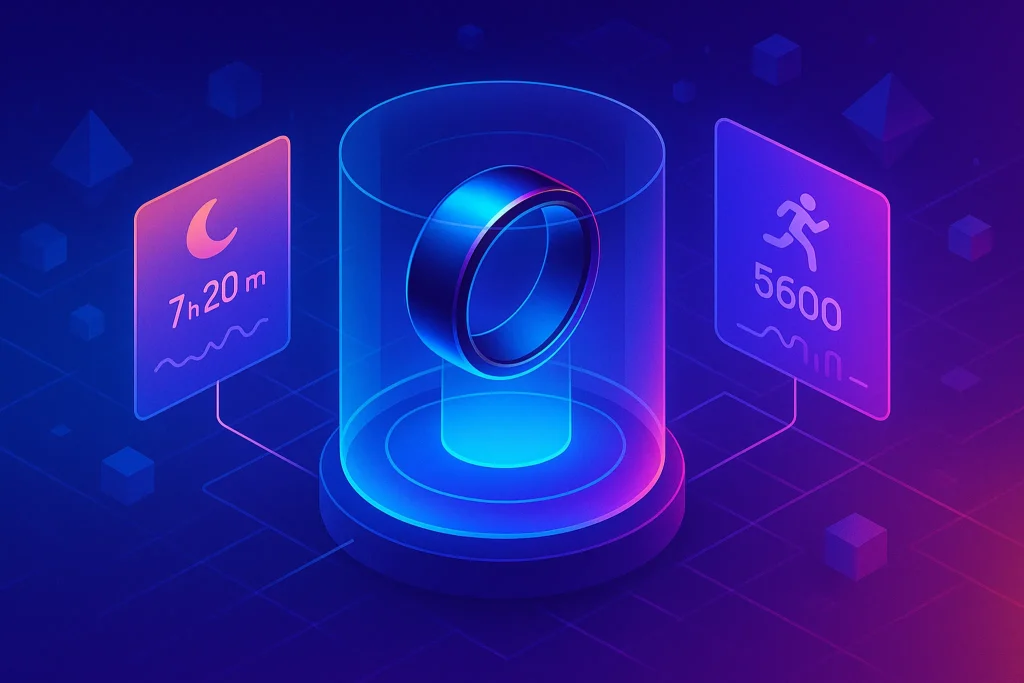📱 Introduction: The Foldable Comeback Nobody Saw Coming
When foldable phones first appeared on the market, many dismissed them as overpriced novelties destined to fade like 3D TVs. But fast forward to 2025, and the narrative has shifted—dramatically.
With over $31 billion in foldable smartphone sales this year alone, the form factor is no longer a gimmick; it’s a serious player in the mobile game. And yet, the question remains: are foldables truly revolutionizing how we use our phones, or are we just being sold a sleeker way to scroll?
In this post, we’ll dissect the real-world experience of using foldables, explore the top models of the year like the Samsung Galaxy Z Fold6, Pixel Fold 2, and OnePlus Open, and weigh the pros and cons from a usability, design, and longevity standpoint.
And if you’re wondering whether you need a foldable in your pocket, we’ve got a whole section just for that.
📊 Foldables by the Numbers: A $31B Signal or a Trend Bubble?
The foldable phone market has exploded in 2025, reaching an impressive $31 billion in global revenue. According to IDC and Counterpoint Research, foldables now make up nearly 8% of premium smartphone sales worldwide—a figure that’s expected to hit 14% by late 2026.
What’s fueling this growth?
-
📈 Improved durability: Early issues like hinge breakdown and display delamination have largely been addressed.
-
🖼️ Bigger, better displays: Users want larger screens without sacrificing portability—and foldables deliver that balance.
-
🔁 Refined UX: App continuity, split-screen modes, and pen support are now built into Android 14 and beyond.
Despite the optimism, some challenges persist. For instance, average return rates for foldables are still higher than traditional smartphones due to user unfamiliarity and concerns over long-term wear.
But make no mistake: brands are betting big. From Samsung’s Z lineup to Huawei’s Mate X series, the competition for foldable dominance is heating up—and consumers are watching closely.
If you’re curious about other transformative devices this year, don’t miss our breakdown of The Most Anticipated Gadgets of 2025, where foldables stand shoulder to shoulder with wearables and XR headsets.
🔍 Foldable Lineup 2025: Who’s Leading the Pack?
Foldables aren’t just one-size-fits-all anymore. In 2025, manufacturers have doubled down on design innovation, UX refinements, and hardware robustness. Let’s explore some of the most talked-about models on the market right now:
💼 Samsung Galaxy Z Fold6
Samsung continues to lead with its sixth-generation Fold. The Z Fold6 features a brighter inner AMOLED panel, slimmer profile, and better hinge protection. Multitasking is buttery-smooth thanks to the Snapdragon 8 Gen 3, and the S Pen support makes it a productivity powerhouse.
A true mobile workstation for creators and professionals, the Fold6 excels in areas where traditional phones feel limiting.
💡 Already compared to previous models? Don’t miss our full Samsung Galaxy Z Fold Review.
📷 Google Pixel Fold 2
Sleek, understated, and laser-focused on AI integration, the Pixel Fold 2 brings the best of Google’s software to a foldable chassis. While it’s not the most durable of the bunch, its camera system and clean Android experience make it a solid pick for everyday users who want something smarter.
-
📐 Aspect ratio optimized for reading and browsing
-
🤖 Native Gemini AI support baked into the OS
-
🔋 Decent battery life, though not record-setting
🔲 OnePlus Open
The OnePlus Open surprised many by striking an excellent balance between performance and price. With minimal crease visibility and robust multitasking software, it’s quickly become a fan-favorite for power users.
-
🛠️ Excellent thermal handling and fast charging
-
🧩 Great app optimization for dual-pane use
-
💸 Under $1,400, making it one of the most affordable foldables this year
🧪 Huawei Mate X5 / X3
While availability is limited outside of China, Huawei’s foldables push innovation hard—especially with their reverse fold mechanics. Their devices often include satellite communication and ultra-slim hinges, but lack Google services, which limits their Western appeal.
📌 If you’re exploring future-friendly phones and wearable ecosystems, our Wearable Tech in 2025 post complements this discussion.
📬 Stay Ahead of the Tech Curve
Join the NerdChips newsletter to get weekly deep dives into emerging gadgets, future tech, and creator tools that actually matter. No hype. Just smart insights.
🔐 We value your privacy. No spam. Just curated tech intel, straight to your inbox.
🧑💻 Are Foldables Better or Just Different?
Let’s be honest—foldable phones look cool. But aesthetics alone don’t justify a $1,500+ price tag. What matters is how they feel to use every day.
-
📖 Multitasking & Split-Screen: Foldables turn app juggling into a seamless experience. Drag-and-drop between windows, floating YouTube while messaging, or sketching while reading a doc becomes second nature.
-
✈️ Portability Without Sacrificing Screen Size: No more choosing between compact phones and large-screen productivity.
-
📸 Creative Use Cases: From tabletop photography with Flex Mode to editing videos in wide aspect ratio, foldables unlock formats others can’t.
But there are trade-offs:
-
🔁 Crease still exists, though less visible than in previous years
-
⚖️ Weight and thickness remain noticeably higher than slab phones
-
💥 Durability anxiety still deters many potential buyers—especially after years of flat-glass habits
Want to know how foldables stack up against wearables in terms of market trajectory? Read our exploration of Smart Glasses: The Next Big Gadget or Just Hype? for a cross-device comparison.
🤹 Who Really Needs a Foldable?
Foldables aren’t for everyone—and that’s okay.
The form factor is best suited to specific user archetypes who can actually leverage its expanded capabilities. If you fall into any of these categories, a foldable might change how you work and play:
🧠 Knowledge Workers & Productivity Junkies
Need to reference PDFs while writing emails? Or sketch out a mind map while on a video call? Foldables offer a multitasking flow you won’t find on traditional phones.
🎮 Gamers & Content Consumers
The wide screen real estate makes mobile gaming feel like a handheld console. It also improves immersive video, especially for 21:9 YouTube content and even VR previews.
🎨 Designers & Creators on the Go
Foldables are perfect for thumbnail previews, light editing, and on-the-fly sketching—especially with stylus support.
🌍 Frequent Travelers
Foldables serve as mini-tablets for watching, working, or reading—without the bulk. Long flight? No problem. Just unfold and go.
That said, if your phone use is light and utility-based, you may be better off investing in a flagship slab or future-focused wearables.
🧭 Learning Curve: Not Everyone Adapts Instantly
Let’s face it—foldables come with a UX learning curve. Features like split-screen gestures, app continuity, and Flex Mode can feel unintuitive at first, especially for users accustomed to traditional slab phones.
On average, users report that it takes 3–7 days of daily use to get comfortable with multitasking workflows and gesture behaviors. For older users or non-tech-savvy demographics, this friction can lead to early frustration.
📌 Takeaway: Foldables offer powerful utility—but they require a mindset shift. If you’re willing to adapt, the payoff is real.
📐 Foldables vs Tablets: Do They Replace iPads?
Another common question: Can a foldable phone replace both my phone and tablet?
For many, the answer is yes—but with caveats.
-
✅ Great for email, reading, mobile browsing, and short-term productivity.
-
❌ Still too small for serious creative work, note-heavy reading, or multitasking with 3+ windows.
If you’re torn between a Galaxy Z Fold6 and an iPad Mini, consider your top use cases. For light work, entertainment, and travel? The Fold might win. For drawing, deep research, or writing? A dedicated tablet could still offer more screen comfort.
Curious how tablets stack up with other mobile innovations? See our analysis in The Most Anticipated Gadgets of 2025 for a wider view.
🧩 Accessory Ecosystem: Beyond the Fold
Foldables don’t live in isolation. Their utility depends heavily on the ecosystem of accessories that support them. Investing in the right gear can drastically improve your experience.
-
Stylus Pens (especially for Galaxy Z Fold) unlock note-taking, sketching, and signature work.
-
Heavy-duty cases are essential—most foldables are glass on both sides and prone to drop damage.
-
App launchers and split-screen utilities help streamline multitasking.
💡 Nerd Tip: Don’t judge foldables without experiencing them with accessories. They often feel “incomplete” without them.
We’ve reviewed several of these tools in Top Futuristic Gadgets You Can Own Now where foldables and their ecosystems feature prominently.
🛍️ Foldable Gear & Accessories to Consider
📦 Thinking About a Foldable? Here’s What You’ll Need
Check out our recommended foldable phones and accessories built for protection, performance, and style:
- Galaxy Z Fold6 – Powerful, durable, and productivity-focused
- Pixel Fold 2 – Great for Google ecosystem users and AI tools
- Spigen Tough Armor Case – Best protection for creased displays
- Magnetic Stylus Pens – Ideal for note-taking on foldable screens
🎥 Not Always Ideal for Vertical Content
Foldables shine in horizontal modes—but what about vertical-first apps like TikTok, Instagram Reels, or YouTube Shorts?
Many foldables display these apps in letterboxed or pillarboxed formats, especially when unfolded. While the cover display is great for quick scrolling, creators and content junkies may find that:
-
📱 Creased areas distract from clean viewing
-
🧩 Vertical editing tools (like CapCut or InShot) sometimes scale oddly on large internal screens
-
🎞️ Posting and previewing content for social often still feels better on a traditional slab
📌 Bottom Line: If your digital life revolves around short-form video, you might want to test a foldable firsthand before switching.
🔮 Foldables vs the Future: Will They Last?
Foldable phones have carved a clear niche, but they’re not without competition.
As AR glasses evolve—with devices like the Apple Vision Pro and Ray-Ban Meta offering hands-free interfaces—the concept of what a “personal device” looks like is being redefined.
Foldables may serve as a transitional format between slab phones and wearables, blending familiarity with innovation. But if battery life, app continuity, and bulk aren’t resolved, they may plateau in the next few years.
Still, for now, they represent the pinnacle of mobile engineering—and for some, that’s more than enough.
❓ FAQ: Nerds Ask, We Answer
🧠 Nerd Verdict
Foldable phones are not for the average user—but they’re not just hype either. For power users, early adopters, and tech-forward professionals, they offer a genuinely new way to experience mobile computing. Yes, creases and hinges still exist. But the value proposition? Stronger than ever.
If you want the bleeding edge of what a phone can do—and are willing to invest—the foldable might be your next upgrade.
💬 Would You Bite?
Would you switch your main phone for a foldable? Or is it still a niche gimmick in your eyes?
Drop your thoughts and let’s see if foldables are truly folding into the mainstream. 👇



